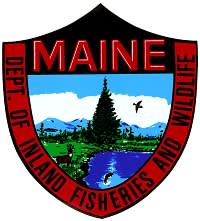Maine IFW Completes Spring Bear Capture Season

Department of Inland Fisheries and Wildlife biologists completed their spring bear trapping season, capturing, radio collaring and releasing 115 bears in the Downeast region of Maine; one of three black bear study areas where the Department actively monitors bears.
This trapping effort is an essential part of the Department’s black bear management program. Capturing and radio collaring black bears allows IFW’s biologists to collect information on birth and death rates to ensure a healthy population of black bears in Maine.
As part of the department’s bear management program, each spring, IFW biologists capture bears with foothold traps, gather biological data such as weight and size, attach radio collars, and then release the bears back into the wild.
“Trapping allows us to capture bears safely and humanely, quickly release bears back into the wild, and gather important scientific data to monitor the health of Maine’s bear population,” said Randy Cross, wildlife biologist and field leader for the department’s bear program. Cross has handled thousands of bears in his 30-year career at IFW, and is one of the most experienced bear capture biologists in the country.
As field leader, Cross oversees three different trap lines, with over 50 cable foothold traps total. Cross utilizes the same type of cable foot snare used during Maine’s eight week fall black bear trapping season. The crew uses Aldrich foot snares, the only legal foothold trap allowed during Maine’s bear trapping season. However, trappers are limited to 1 trap/trapper.
Each day, biologists checks the trap lines to see if any bears have been captured with the cable foothold traps.
Even with the large number of traps and the fact that bears are actively looking for food this time of year, some days biologists will not capture any bear, and on other days, they will capture several. Biologists lure bears to the area of the traps with food such as animal carcasses and pastries. Generally, they will capture between 1-3 bears each day.
When biologists discover they have successfully caught a bear in a trap, they will first anesthetize the bear, and then begin gathering biological data.
They will examine the bear for ear tags and a tattooed identity number on the inside of the bear’s mouth to see if it has been captured before. If none are found, they will place tags on the ears, and mark the same tag number inside the bear’s mouth.
Biologists then examine the bear to see if it is healthy or injured, note the sex of the bear, measure the size of the bear and weigh it. If it is a female, the bear will be equipped with a radio collar so biologists can locate the bear in the winter to see if the bear has cubs, and gather other data.
The captured bears are then released, generally within 45 minutes of being anaesthetized. Data gathered from each bear is compiled then analyzed during the winter.
MDIFW’s bear monitoring effort occurs in three study areas. This year biologists trapped in the Downeast region of the state. Other study areas include an area in the north Maine woods, and one area in the central Piscataquis County. The three areas are representative of bear habitat throughout the state.
The Department of Inland Fisheries and Wildlife began the bear study in 1975, and since that time, more than three thousand bears have been captured and marked.
The Department tracks between 79 and 100 radio collared black bears annually, and generally inspect over 80 bear dens each winter. The den visits also provide biologists with crucial information on Maine’s black bears including birth rates, survival, behavior, and bear health and nutrition.
By monitoring Maine’s bear population closely, the Department can adjust rules and regulations concerning the bear hunting season to meet bear population objectives and ensure the conservation of the population.
Maine’s bear population is rising, and is estimated at more than 30,000 bears. Maine has the largest bear population in the east and one of the largest in the continental US. Maine’s bear population has risen by 67 percent since 1990, and in the past ten years has grown from 23,000 bears in 2004 to over 30,000 currently.

